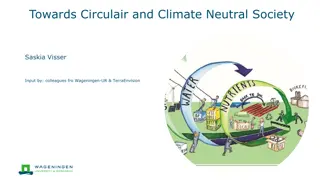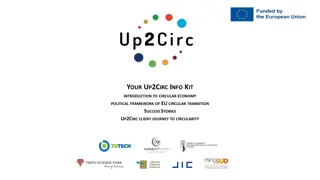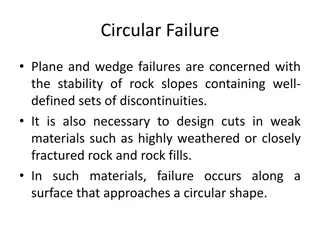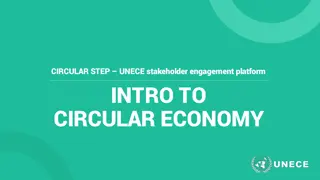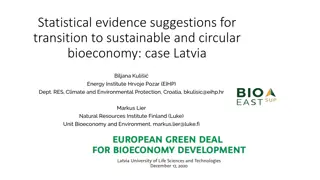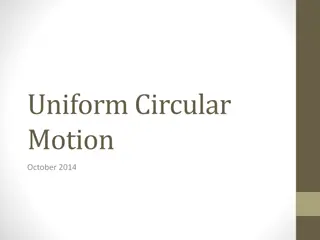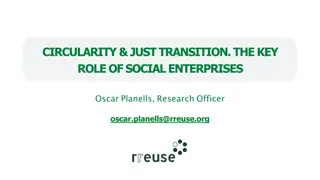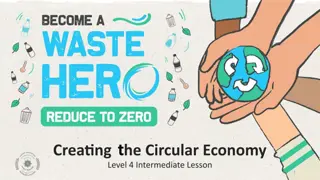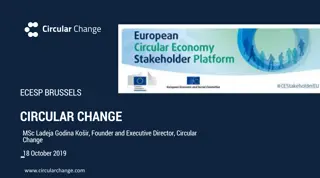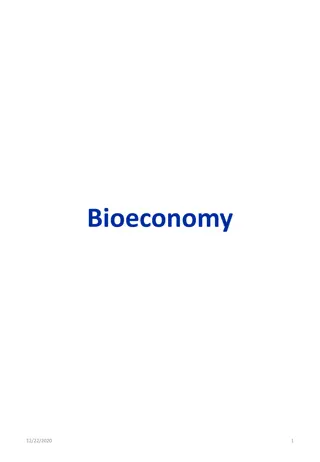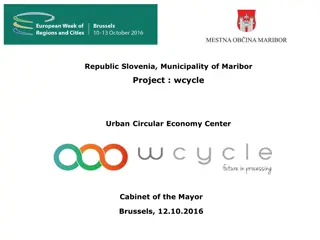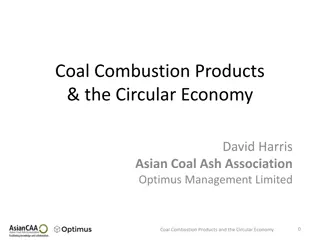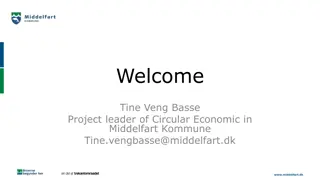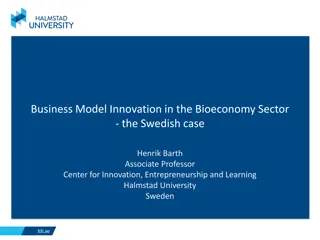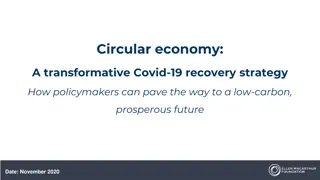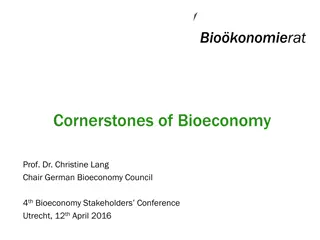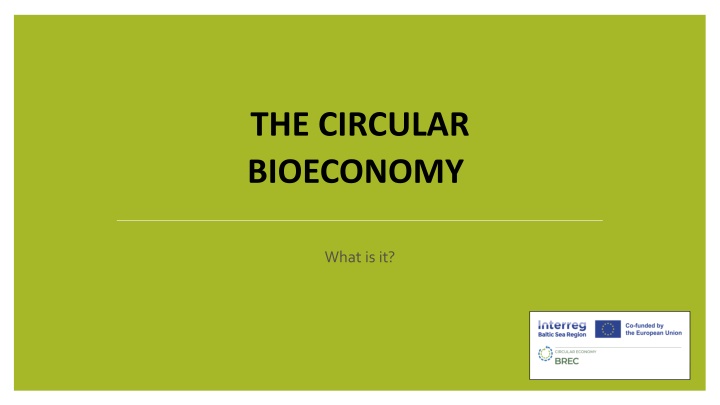
Circular Bioeconomy: Sustainable Strategies, Examples, and Impact
Explore the circular bioeconomy, including its difference from the linear model, main production steps in biorefineries, and strategies for transitioning to a more bio-based economy. Learn about the use of biogas and residual products, discuss circular systems, and discover the positive environmental impact through examples like CO2 savings and renewable energy sources.
Download Presentation

Please find below an Image/Link to download the presentation.
The content on the website is provided AS IS for your information and personal use only. It may not be sold, licensed, or shared on other websites without obtaining consent from the author. If you encounter any issues during the download, it is possible that the publisher has removed the file from their server.
You are allowed to download the files provided on this website for personal or commercial use, subject to the condition that they are used lawfully. All files are the property of their respective owners.
The content on the website is provided AS IS for your information and personal use only. It may not be sold, licensed, or shared on other websites without obtaining consent from the author.
E N D
Presentation Transcript
THE CIRCULAR BIOECONOMY What is it?
Learning Goals The difference betweenthe linear and cicular bioeconomy Main production steps in biorefineries Sustainable strategies for the transition to a more bio-basedeconomy Use of biogas and residual products from biorefineries
The term bio economy definition: Bioeconomy is an economy where materials, chemicals and energy originate from renewable bio-based raw materials.
The concept of linear economy definition: Linear economy is an economy that extracts natural resources, produces, distributes, consumes and then eventually turns into waste. Use Waste Manufacturing
The concept of circular economy definition: In a circular economy, resources stay within society's cycle instead of becoming waste Manufacturing Recycling Use
Summary of the concept of Bioeconomy" https://www.youtube.com/watch?v=hx-jZmE-2_U
Why a Circular Bio Economy ? (school task ) Discussion in small groups - Give examples of circular systems -What do we have to gain from increasing the use of biocircular systems?
Some examples of the circular bioeconomy's positive impact on the environment Save 2.5 billion CO2 equivalents/year in the EU Biogas from stable manure an important source of energy that mitigates the climate impact of greenhouse gases Renewable ethanol - reduces greenhouse gas emissions by 77% compared to with fossil fuels Biodiesel can achieve significant reductions in emissions in the range of 50%- 90% compared to conventional diesel
Terms and statements - match the correct term with the correct statement . (Write the term number in front of the correct statement) The amount of greenhouse gases released into the environment by an activity, group, process, or individual, usually measured in kilograms of carbon dioxide. 1. Circular bioeconomy A refinery that converts biomass to energy and other beneficial by-products (such as chemicals). A renewable type of fuel derived from plants and animals such as vegetable fats or grease to be used in diesel engines. 2. Blue bioeconomy 3. Biogas Closing the loop and recycling, repurposing biological resources. 4. Biobased Based on biological materials, especially agriculture or forest resources. 5. Biometan (RNG) A type of charcoal made from biomass, that is used to improve nutrition in the soil. 6. Emissions Fertilizer of biological origin, which contains live microorganisms. 7. Bioreffinery Also known as renewable natural gas is a biogas that has been upgraded to a quality similar to fossil natural gas and has a methane concentration of 90% or higher. It is obtained by removing CO2 and other impurities from biogas. 8. Biomass Product made from a renewable plant source as opposed to petroleum. 9. Biofertilizer An economic term related to the exploitation, preservation, and regeneration of the marine environment. 10. Biochar Plant material, vegetation or agricultural waste used as a fuel or energy source. 11. Bioplastics A substance discharged into the air, usually by an internal combustion engine 12. Biodiesel A mixture of methane and carbon dioxide, produced by bacterial degradation of organic matter, and used as fuel. 13.Carbon footprint
Terms/Dictionary Biomass: plant material, vegetation or agricultural waste used as a fuel or energy source. Circular bioeconomy: closing the loop and recycling, repurposing biological resources. Carbon footprint: the amount of greenhouse gases released into the environment by an activity, group, process, or individual, usually measured in kilograms of carbon dioxide. Bio-based: based on biological materials, especially agriculture or forest resources. Biofertilizer: fertilizer of biological origin, which contains live microorganisms. Carbon dioxide equivalents:is a way of indicating how large a greenhouse effect an emission of a gas has in comparison with emissions of the same amount of carbon dioxide Biochar: a type of charcoal made from biomass, that is used to improve nutrition in the soil. Emissions: a substance discharged into the air, usually by an internal combustion engine. Biodiesel: a renewable type of fuel derived from plants and animals such as vegetable fats or grease to be used in diesel engines. Biogas: a mixture of methane and carbon dioxide, produced by bacterial degradation of organic matter, and used as fuel. Bioplastics: product made from a renewable plant source as opposed to petroleum. Bio-methane (RNG) also known as renewable natural gas is a biogas that has been upgraded to a quality similar to fossil natural gas and has a methane concentration of 90% or higher. It is obtained by removing CO2 and other impurities from biogas. Blue bioeconomy: an economic term related to the exploitation, preservation, and regeneration of the marine environment. Bioreffinery: a refinery that converts biomass to energy and other beneficial by-products (such as chemicals).
Why biorefining? Use of organic materials for the production of products and energy Environmentally friendly use of plants ,algae and waste Chemical, thermal and physical processing
Examplesofbiorefineries Biorefineries are facilities for the production of products from biomass Biogas production Protein extraction Seaweed biorefinery
Refinery forage crops
Areas of use for Biogas and residue Biogas Pros : Thermal energy (heat), Renewableresource that reduces dependenceon non-sustainable alternatives Fuel Electricity Bioplastic Efficient use of organic waste Residue Cons : Fertilizer Dependence on sufficient access to raw materials Animalbedding High costs and investments in infrastructure Soilamendments
Areas of use for extracted protein Protein juice Pos: High-quality protein for high- performance ruminants and monogastrics animals Reduces dependence on imported protein feed (soy) Possibility for crop farms to include forage plants in the crop rotation Press cake (residual) Feed for low-performing animals, Cons : Biogas production High costs for investments Biochar production Dependent on availability of high-quality grass and clover Textile Fibers
Pyrolysisprocess and products Biochar Process Carbon sequestration Heating bio mass Soil improvement Up to 500-600 C without oxygen, Energy production Biogas and Bioil mnet s nderfaller utan f rbr nning Vid pyrolys avg r gaser och en terstod i fast eller flytande form Heating Power generation Fuel Syngas As above, also as a raw material in the chemical industry
Sustainable strategies for the transition to a more bio-based economy Great need for knowledge broad educational activities General reduction of consumption for a sustainable future Using renewable resources a natural resource that depletes more slowly than it is replenished Efficient material flows especially with regard to carbon. Make optimal use of production waste Use degradable products Implement effective collection systems
The Paris Agreement A treaty combating climate change. It aims to limit global temperature rise to well below 2 C above pre-industrial levels. Every signatory country works toward agreed-upon goals. For example, Sweden pledge to become carbon-neutral (have net-0 emissions) by 2045. Finland is one of Europe s most ambitious countries, wanting to achieve climate neutrality by 2035. (Ministry of Foreign Affairs in Finland). Almost the entire world is working towards achieving climate neutrality by 2050
HOW WONDERFUL IT IS THAT NOBODY NEED WAIT A SINGLE MOMENT BEFORE STARTING TO IMPROVE THE WORLD ~ ANNE FRANK

